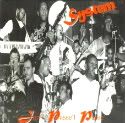 NewsHammer Exclusive
NewsHammer Exclusive
It's taken a while to get an overview of the global impact of the deadly H1N1 Swine Flu outbreak in Mexico back in April. It doesn't look good. The World Health Organization reports over 700 dead worldwide, a dramatic doubling of fatalities this month. 116 countries have laboratory confirmed cases of H1N1 as of July 6, 2009. The WHO's latest summary, July 16, 2009 (included in a change on its H1N1 reporting guidelines):
The 2009 influenza pandemic has spread internationally with unprecedented speed. In past pandemics, influenza viruses have needed more than six months to spread as widely as the new H1N1 virus has spread in less than six weeks.The WHO also notes that the continued spread of the pandemic to all countries is inevitable.
The last time an influenza pandemic moved something near as fast, was the H1N1 Spanish Influenza of 1918 that killed 50 to 100 Million. As reported first in NewsHammer, there are other similarities between the Spanish Flu and the current pandemic, officially declared finally on June 11, 2009 by the WHO, too late to contain it.
Recently a trickle of patient data has become available as well as the first major study of this new or novel Influenza A (H1N1). Although they are different, the current H1N1 does behave in a similar manner to Spanish Influenza H1N1. If similarities hold then this first outbreak could mutate into a later more virulent second stage attack like Spanish Flu did.
The UW-Madison Study published in Nature July 13, 2009 confirms that people born before 1920 who were exposed to H1N1 then, carry protective antibodies to the current N1H1. Clearly both pandemic influenzas are similar in effect.
 Even though there are common seasonal H1N1 influenzas circulating now, those who've become ill with them won't have any immunity to today's pandemic H1N1. The new H1N1 also replicates more efficiently than seasonal influenzas, and so people get sick faster. Some are overwhelmed by the virus's virulence, needing hospital care while some die because the new H1N1 penetrates deeper, spreading from the nose into the lungs, unlike seasonal head cold influenzas, and causing lung damage, leading in some cases to pneumonia, organ failures and death. It's also highly contagious, way more than seasonal flus. It takes the same route though, into the nose as you breathe in contaminated droplets of water from sneezes and coughs from people already infected. But it also can pass from a contaminated hand if you touch your nose, hence the frequent need for hand washing.
Even though there are common seasonal H1N1 influenzas circulating now, those who've become ill with them won't have any immunity to today's pandemic H1N1. The new H1N1 also replicates more efficiently than seasonal influenzas, and so people get sick faster. Some are overwhelmed by the virus's virulence, needing hospital care while some die because the new H1N1 penetrates deeper, spreading from the nose into the lungs, unlike seasonal head cold influenzas, and causing lung damage, leading in some cases to pneumonia, organ failures and death. It's also highly contagious, way more than seasonal flus. It takes the same route though, into the nose as you breathe in contaminated droplets of water from sneezes and coughs from people already infected. But it also can pass from a contaminated hand if you touch your nose, hence the frequent need for hand washing.
The Study also notes that "sustained person-to-person transmission might result in the emergence of more pathogenic variants, as observed with the 1918 pandemic virus". That point was also made in NewsHammer back in May, "H1N1 Mexican Swine Flu: A Two Stage Attack And The New Spanish Influenza?".
We have to be prepared for a killer pandemic that might mutate like the Spanish Influenza. And we're going that route with mass vaccinations on the way. A shot of a weakened H1N1 will produce protective antibodies that will neutralize the real H1N1 virus. We'll be protected in a similar way as those who recovered from the Spanish Influenza and are immune to today's threat. Mass vaccinations are our best hope to stop the current pandemic.
On the positive side, the vast majority of current infections are mild, requiring no hospitalization. Mild cases may now number a million or more in the U.S. As of last week U.S. fatalities numbered 263, up from 170 as of July 6th.
There's still the European Center for Disease Prevention and Control that's doing global monitoring. As of July 20, 2009 we have as many as 140,000 confirmed cases according to the ECDC.
The best and last global guideline we have from the WHO is 94,512 confirmed cases, 429 dead as of July 6, 2009. Or about a 0.45% chance of dying if you have been diagnosed with H1N1. Those hospitalized for H1N1 have a much higher 5% chance of dying. If the U.S. trend continues with infections estimated at a million now, 263 dead out of 40,617 confirmed cases, and ultimately hitting 30% to 50% of the population as one of the leading vaccine producers, Novartis AG expects, we might see a lot more deaths within a year if there's no vaccine available. In the U.S. based on the above statistics it could be as high as 22,092 to 36,820 dead.
The U.S. Centers for Disease Control, the CDC made its own estimates last month but only released them today, July 24th to AP. Up to 40% of Americans could get H1N1 within 2 years. Deaths could range from 90,000 to several hundred thousand. Again if there's no effective vaccine. But how did the CDC arrive at such high numbers? During the Spanish Influenza doctors and nurses were dying, hospitals were always packed. Many of the sick couldn't get any help. Economies, infrastructure crashed.
If the current virus mutates dangerously it could be mean a worldwide collapse. More virulent or less virulent strains of H1N1 will change the odds. In the Northern Hemisphere we haven't entered the seasonal flu season yet but when we do researchers expect that we'll see a resortment of its genetic material when it combines with other flu viruses circulating. This is the mechanism by which H1N1 evolved in the first place. The odd thing is we have not only deadly H1N1 but a great number of cases of mild H1N1 flu spreading wildly as though we're in the winter flu season now.
That's why there is a rush to get a new vaccine out that prevents or mitigates the consequences of H1N1 infection. The U.S. has already ordered $289 Million of vaccine from Novartis back in May and has placed further orders totaling $979 Million, plus with other manufacturers to inoculate the entire U.S. population. Vaccine trials in the U.S. should start soon and if all goes well the U.S. will have 160 Million doses available in October. In the U.S. and elsewhere health professionals will be first in line for immunization.
The last influenza pandemic in 1968, an avian flu, killed about 700,000 people worldwide. The 1957 flu pandemic killed about 70,000 Americans. And we still have a serious threat developing of another bird flu pandemic, the recent H5N1, still spreading and killing people: 262 dead as of July 1, 2009.
Plans for a massive vaccination campaign in many countries show that governments are expecting a worst case scenario. Some are also stockpiling the two major flu antivirals, Tamiflu and Relenza, that are used in serious flus and have been beneficial in cases of H1N1. Though lately 5 cases of H1N1 have been shown to be resistant to Tamiflu, with more being reported, a new worry that suggests H1N1 can rapidly mutate, and might become generally resistant. The problem is that Tamiflu is widely used to treat any severe flu and some people have been taking it as a preventative. A man in Quebec took it that way, but at less than the recommended dosage and caught H1N1 from his son. Seems the virus became Tamiflu resistant in his own body. Some parents are sending their kids to camp with Tamiflu in their backpacks as insurance, but wide spread and unnecessary use as we've had with antibiotics is just going to speed up Tamiflu resistance in H1N1. There are very few antivirals as it is. If a vaccine that works isn't out in time, we will be in big trouble.
No results yet on any vaccines at a clinical trial stage. But 2 different H1N1 vaccines are being tested.
 Novartis AG developed the first H1N1 vaccine back in June, in a new type of mammalian cell culture. Clinical trials started in July according to the Novartis AG website. This type of vaccine hasn't been tested widely, about 3500 people treated for other diseases. It promises to be much quicker to produce than chicken egg embryo incubation. Gearing up for extreme mass production of an effective vaccine might be a lot slower than anticipated. H1N1 isn't easily produced in chicken eggs, the standard medium, as it yields a third to a half of what other influenzas produce. Then too, researchers are saying that two shots of vaccine will probably be needed per person, spaced apart, for effective immunity.
Novartis AG developed the first H1N1 vaccine back in June, in a new type of mammalian cell culture. Clinical trials started in July according to the Novartis AG website. This type of vaccine hasn't been tested widely, about 3500 people treated for other diseases. It promises to be much quicker to produce than chicken egg embryo incubation. Gearing up for extreme mass production of an effective vaccine might be a lot slower than anticipated. H1N1 isn't easily produced in chicken eggs, the standard medium, as it yields a third to a half of what other influenzas produce. Then too, researchers are saying that two shots of vaccine will probably be needed per person, spaced apart, for effective immunity.Although Australia has been hit hard with H1N1, 14,703 confirmed cases and 41 deaths as of July 22, 2009, there's some good news. The first Australian clinical trials of an H1N1 vaccine are underway. Results will be available in another 6 weeks.
Trials started July 20, 2009, but one of the biotech companies involved, Vaxine, isn't promising any miracles.
Vaxine research director Nikolai Petrovsky told BBC News that there "is no guarantee any of these vaccines will work. Swine flu is a very peculiar beast, it's a very different virus that we're dealing with. But we are hopeful."
What is striking and disconcerting are the contrary comments from researchers and labs that an H1N1 vaccine is not difficult to make or produce, as there's plenty of experience gained from seasonal flu vaccines and that results should be in line with expectations, that like seasonal flu vaccines, an H1N1 will work. So much so that in Britain, according to The Independent, "high risks groups such as children are likely to receive the vaccine before the final clinical trial results are in."
Since new technologies are involved in the production of some pandemic vaccines, which have not yet been extensively evaluated for their safety in certain population groups, it is very important to implement post-marketing surveillance of the highest possible quality. In addition, rapid sharing of the results of immunogenicity and post-marketing safety and effectiveness studies among the international community will be essential for allowing countries to make necessary adjustments to their vaccination policies.
Currently 850-900 Million doses of vaccine have been ordered by governments, on a one dose per person basis, says the WHO, or full coverage for wealthy countries. Most have options or are considering options for 2 doses per person, doubling the demand to 1.8 Billion doses. But orders are from higher income countries for their needs.
Nature, "In vitro and in vivo characterization of new swine-origin H1N1 influenza viruses", July 13, 2009 U-W Madison
Nature News, "Swine flu shares some features with 1918 pandemic", July 13, 2009
U Wisconsin School of Medicine, "UW-Madison Study: H1N1 More Dangerous Than Suspected", July 13, 2009
NewsHammer, "H1N1 Mexican Swine Flu: A Two Stage Attack And The New Spanish Influenza?", May 22, 2009

















0 comments
Post a Comment